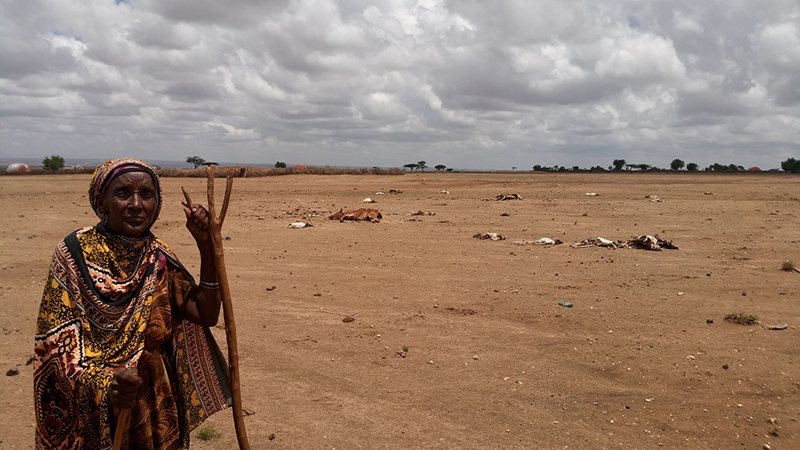From vast forests and barren deserts to rich, green arable land, East Africa boasts a variety of landscapes that have all, to some extent, been modified by the humans who live there.
But its equally diverse climate, which has historically shaped the land and the life of its inhabitants, is now becoming so unruly that people struggle to adapt.
Despite all their differences, East Africa and the Horn of Africa have one thing in common: a susceptibility to weather extremes, be it dry spells or violent floods.
The ruthless impacts of these events have been devastating for key sectors such as agriculture and livestock farming, but have also caused the displacement of millions of people in the last decade alone.
Weekly briefing: Sign up for your essential climate politics update
“Since 2009, an estimated one person every second has been displaced by a disaster” says Yohannes Hagos Subagadis, a hydrologist and risk reduction expert working for the Norwegian Refugee Council.
Subagadis has been recently despatched by UNESCO to Juba, in South Sudan, where he experienced first-hand what climate change is doing to people already battered by conflict.
In a long email exchange between flights, from Juba to Norway where he gave a talk at a major conference, and back to Addis Ababa in Ethiopia, he told me about his experience in helping communities reduce their vulnerability to extremes.
“Climate induced displacement is gaining attention only recently,” he says. “But it is a fact that it is a large-scale, widespread global crisis which is set to rise. The International Displacement Monitoring Center estimates that an average of 22.5 million people have been displaced by climate or weather-related events since 2008”.
These figures are overshadowed by the even bigger numbers of refugees who fled their homes because of the ongoing conflict in the region. But Subagadis stresses how the two problems cannot be tackled separately.
“Human made factors such as conflicts, bad governance, unplanned urbanization or poverty are inter-twined with natural hazards, which in turn determine the devastation and level of displacement,” he writes.
“For example, even though conflict-induced displacement is widely reported in South Sudan, climate-related challenges do have significant impact to both displaced and not-displaced.
“South Sudan’s main sources of livelihood – rain-fed agriculture and livestock – entirely depend on weather, and higher mean temperatures, a longer dry season and heavier and more concentrated rains are only set to increase the suffering of displaced communities.”
Resilient Africa: Climate-smart beans offer hope to Uganda’s farmers
The link between a changing climate and forced migration is a complex one, because it can be difficult to capture.
Subagadis explains that although the dynamics between climate change induced and other form of displacement still have to be fully understood, there is clear indication that climate-related disasters are followed by slow and rapid-onset movement of people.
It is in this highly uncertain context that risk preparedness specialists operate – helping people protect their homes. From a hydrologist’s perspective, the first and crucial tool to prioritise in the fight against unpredictable wicked weather is better forecast.
Subagadis believes that to help decision makers do the right thing when it comes to re-design infrastructure and protect farmers and urban poor from disasters, timely forecast is crucial.
Particularly in the developing world, it can make a difference between a year of yields lost to a dry spell or a building collapsed under a wave of mud, and marginal and reparable losses.

Yohannes Hagos Subagadis, a hydrologist and risk reduction expert working for the Norwegian Refugee Council (Pic: NORCAP Ida Sem Fossvik)
“While climate change-related hazards affect developed and developing countries alike, the latter suffer from higher climate risks due to higher exposure and vulnerability,” he writes.
“In the case of Africa, for example, droughts account for only 20% of the disasters in the continent, but for more than 80% of the population affected by a natural hazard.”
To many poor countries, information and data gathering infrastructure remain at the bottom of their priorities, but over time better monitoring can have an influence that goes beyond predicting the next rains.
“What we call climate services involve gathering a vast body of information such as temperature, rainfall, wind, soil moisture and ocean conditions, as well as maps, risk vulnerability analyses and long term projections,” Subagadis says.
For countries battling with development priorities such as hunger and sanitation building such a complex infrastructure is no small feat, but the hydrologist assures that the benefits would be tangible.
“Risk assessment and mitigation are important not only in case of rare weather extremes, but they also have a direct impact in fields such as agricultural development, the spread of infectious diseases and the availability of fresh water in regions from which people are pushed away because of its scarcity.”
Lou Del Bello’s series of reports on Africa and climate change is funded by CDKN.
